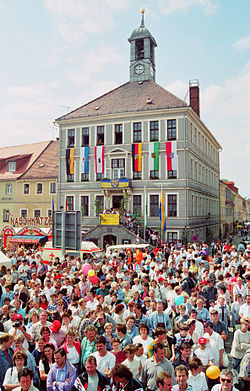Bischofswerda
| Bischofswerda | ||
|---|---|---|
 |
||
|
||
| Coordinates: 51°7′39″N 14°10′47″E / 51.12750°N 14.17972°ECoordinates: 51°7′39″N 14°10′47″E / 51.12750°N 14.17972°E | ||
| Country | Germany | |
| State | Saxony | |
| District | Bautzen | |
| Municipal assoc. | Bischofswerda | |
| Government | ||
| • Mayor | Andreas Erler (CDU) | |
| Area | ||
| • Total | 46.26 km2 (17.86 sq mi) | |
| Population (2015-12-31) | ||
| • Total | 11,573 | |
| • Density | 250/km2 (650/sq mi) | |
| Time zone | CET/CEST (UTC+1/+2) | |
| Postal codes | 01877 | |
| Dialling codes | 03594 | |
| Vehicle registration | BZ, BIW, HY, KM | |
| Website | www.bischofswerda.de | |
Bischofswerda (German pronunciation: [ˌbɪʃɔfsˈveːɐ̯da]; Upper Sorbian: Biskupicy, Polish: Biskupice) is a small town in Germany at the western edge of Upper Lusatia in Saxony.
The town is located 33 km to the east of Dresden at the edge of the Upper Lusatian mountain country. The town is known as the "Gateway to Upper Lusatia" – "Tor zur Oberlausitz" in German. It is located in the district of Bautzen. The town is 18 km west of Bautzen itself. Großdrebnitz is among its quarters. The river Wesenitz flows through Bischofswerda.
The first documentary evidence of the existence of Bischofswerda dates from 1227. Nominally the town was founded by the Bishops of Meissen, though it may have existed before that point. In 1288 city walls were constructed. The first mention of Bischofswerda as a city is in a document dating from 1361. The town remained under the authority of the Bishops of Meissen until 1559 when power was transferred to Augustus, Elector of Saxony, who introduced Protestantism. The city arms are based on a 14th-century seal and consist of two crossed bishop's croziers and four stars. The significance of the stars is not known.
Like many late medieval towns, Bischofswerda suffered from periodic fires that damaged the town. Fires are recorded in 1429, 1469, 1528, 1583, 1596, 1641, 1671 and 1813. The last fire was the worst. During the War of the Sixth Coalition, Napoleonic forces had occupied Bischofswerda when a fire broke out within the town walls on 12 May 1813, destroying most of the medieval town. However the town was rebuilt on an order of Frederick Augustus I of Saxony in a manner closely following the earlier layout, and this remains to this day.
...
Wikipedia



